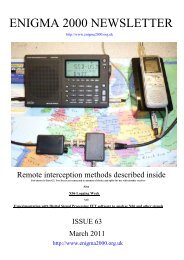Download - Mystery Signals - Support
Download - Mystery Signals - Support
Download - Mystery Signals - Support
Create successful ePaper yourself
Turn your PDF publications into a flip-book with our unique Google optimized e-Paper software.
Also at this time, ground stations were developed which were capable of following the small fighter aircraft and larger bomber aircraft. The weight of sets<br />
for fitting to fighter aircraft eventually became as low as 4 kilogram’s. This transmitter worked on the 150 meter waveband, had a 15 meter wire aerial, and<br />
had a power supply from a generator, which was again linked to the aircraft engine. The receiver worked on the same frequency as the transmitter.<br />
By 1917, there were so many quenched spark gap transmitters in use on the Western Front that they were causing large amounts of interference to each<br />
other. The only solution was to develop new equipment. Unfortunately it was mid 1918 before suitable equipment using the then new valve/vacuum tube<br />
technology became available. It was not possible to fit suitable wireless equipment to the German aircraft and airships prior to the end of the war. One set<br />
which did become available, although too late for wide spread service, was a transmitter receiver which worked in the frequency range 350 to 750 metres.<br />
These sets had 5 watt valves (tubes), which acted as master oscillators, an audion receiver, and 4 valve (tube) amplifiers. The DC power supply was from a<br />
generator driven by the aircraft engine. This equipment made wireless telegraphy possible.<br />
In the field of wireless direction finding, (later to be known as radio location) for the position fixing of aircraft, successful results were also obtained.<br />
Equipment and techniques were also perfected which allowed the accurate cross bearings of transmitters to be taken, and the location of the transmitter<br />
accurately fixed. On the following pages are shown some of the sets and the aircraft in which they were installed.<br />
TELEFUNKEN AIRCRAFT WIRELESS STATION TYPE 262F.<br />
TELEFUNKEN AIRSHIP WIRELESS STATION INSTALLED IN A “PARSIVAL”<br />
TYPE AIRSHIP.<br />
TELEFUNKEN WIRELESS STATION FITTED IN<br />
A TWO SEAT RECONAISSANCE AIRCRAFT.<br />
AIRCRAFT: GERMAN GOTHA TYPE: - TWIN ENGINED BOMBER<br />
DETAILS:<br />
CREW 3 MEN<br />
Thanks HJH<br />
PoSW’s excellent “Items of Interest in the Media”:-<br />
Items of interest in the media:- Special Relationship My a*s*!, might be the reaction of the average Brit to a story in the Daily Express of<br />
25-November under a headline, "How US spies snooped on Blair's private calls", the article by Paul Thompson in Washington and says,<br />
"American spymasters snooped on the private life of former prime minister Tony Blair, it has emerged. He was given the code name<br />
Anchory, his private telephone calls were monitored and recorded and a file on him was compiled by the secretive National Security Agency.<br />
The admission was made by an ex-Navy communications operator who worked at Fort Gordon, Georgia. David Murfee Faulk told an ABC<br />
News investigation unit he saw a file on the private life of Mr Blair in 2006. He said security clearances at the NSA base allowed him<br />
access to top secret pieces of information. He also said US spymasters bugged telephone conversations of Iraq's first interim president, Ghazi<br />
Al Yawer. Mr Al Yawer and Mr Blair were considered two of America's allies for the 2003 invasion of Iraq........The admissions will cause<br />
huge embarrassment to President Bush and No 10 Downing Street.<br />
46
















